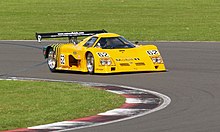Ford C 100
| ford | |
|---|---|
|
Ford C 100
|
|
| C 100 | |
| Production period: | 1981-1982 |
| Class : | race car |
| Body versions : | Coupe |
| Engines: |
Petrol engines : 1.8–3.9 liters (405–441 kW) |
| Length: | |
| Width: | 1710 mm |
| Height: | |
| Wheelbase : | |
| Empty weight : | 880 kg |
The Ford C 100 is a sports prototype from the car manufacturer Ford , which was developed and built in Cologne according to the rules of Group C, which came into force in 1982 . The designation is reminiscent of the successful Ford GT40 of the 1960s, and includes the class designation (GT or size C) and the prescribed roof height (40 inches or 100 centimeters).
development
In Group C, gasoline consumption was limited, but the engine design and displacement could be selected almost at will. This is similar to the situation at Le Mans in 1975 , when similar rules applied after the oil crisis. The Ford Cosworth DFV V8 engine, which has been victorious in Formula 1 since 1967 and which had previously always been problematic on long journeys due to vibrations, was the engine in the three vehicles that came first. Also in 1980 a sports car with a Cosworth engine won against a disguised Porsche 936 with a turbo engine.
So Ford gave the green light with justified optimism for the development of the sports prototype C 100. The Cosworth engine, which in Formula 1 was now also inferior to the turbo engines as a short-stroke DFY three-liter with around 386 kW (525 hp) , was enlarged as DFL to 3.9 liters displacement. So it should be able to deliver more power and torque, especially since the competitors from Porsche and Lancia had turbo engines with around 441 kW (600 PS). The reliability of the DFL suffered as a result, and at Le Mans in 1982 and 1983 it was disappointing in both the C 100 and other vehicles. The DFL variant of the Cosworth engine was reduced to 3.3 liters. The Ford factory project was discontinued at the end of 1982 after only one full season, similar to the Ford P68 prototype from 1968 and 1969, which was also equipped with the Cosworth V8 .
Racing history
Alain de Cadenet registered a C 100 for Le Mans in 1981 , but the works car did not make its debut until the fall of 1981 at the 1000 kilometers of Brands Hatch . Manfred Winkelhock and Klaus Ludwig achieved the best time in practice, but retired from the race with a gearbox damage.
In the sports car world championship , the results were mixed. In the 1000 km race at the Nürburgring in 1982 Winkelhock put the C 100 on pole position with a time of 7: 16.570 minutes, seven seconds ahead of Lancia. He also achieved the fastest race lap on lap 25 with 7: 23.87 minutes (185.190 km / h), but after 32 of 44 laps Ludwig / Winkelhock retired with differential damage. At Le Mans, both works cars retired early with electrical damage. At Brands Hatch Winkelhock put two of the three works cars on the front row, but the best final result was achieved by Jonathan Palmer and Desiré Wilson in fourth place.
After the factory exit, the now privately used Ford C 100s were meaningless in the 1983 World Sports Car Championship .
The C 100 made its debut in the German racing championship in March 1982 in Zolder . The orange “ Jägermeister ” -C 100 by Klaus Ludwig, used by Zakspeed , started from fourth place on the grid, but was eliminated. Klaus Niedzwiedz won Group 5 in Zakspeed's well-tried Ford Capri Turbo . This was repeated at the Hockenheimring , but Ludwig was still tenth in the ranking. The next races were skipped, and two months later at the Norisring there were two C 100's at the start, in fourth and fifth place. Manfred Winkelhock in the white " Liqui-Moly " car drove the fastest race lap and finished second, only just beaten by the new works Porsche 956 . Things went even better at the Hockenheimring in the framework race of the DRM for the German Grand Prix : Ludwig managed both the race victory and the fastest lap despite a jump start, which was punished with a one-minute time penalty . Ludwig also managed to win on the start and finish loop of the Nürburgring .
At the end of the DRM season, two drivers in old Porsche 936s were ahead. For 1983 it was foreseeable that the new Porsche 956 would dominate, which they also did in the DRM: Porsche driver Bob Wollek won both 1982 and 1983, and Klaus Niedzwiedz came third in both years.
Zakspeed also used a modified C 100 in 1983. These were designated as C1 / 8 when the eight-cylinder was on board, and C1 / 4 with the proven 4-cylinder turbo engine with 1.8 liter displacement from the Group 5 Capri, which developed 412 kW (560 hp). With the V8, Klaus Niedzwiedz won at Hockenheim, Ludwig set the fastest lap with the C1 / 4. Ludwig also succeeded in doing this on the airfield courses in Mainz-Finthen and Diepholz . Despite two second and third places, however, it was foreseeable that victories would henceforth be achieved by a Porsche 956. In 1984 they were almost among themselves, even if the Zakspeed cars could still achieve two fourth places. Then Zakspeed switched to Formula 1.
In the Interseries , the C1 / x were used from 1983 to 1988, and were also victorious in the first three years.
Web links
Individual evidence
- ↑ http://wsrp.cz/wsc1981.html#15
- ↑ http://wsrp.cz/wsc1982.html#3
- ↑ http://wsrp.cz/drm1982.html#1
- ↑ Ford C100 C1 / 4. zakspeed.de, accessed on December 4, 2012 .
- ↑ http://wsrp.cz/interserie1988.html


